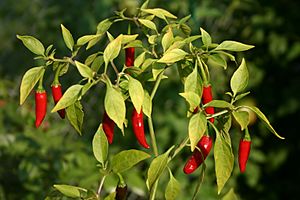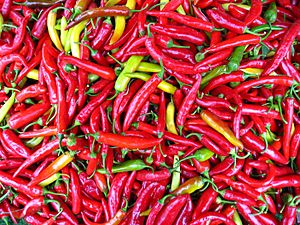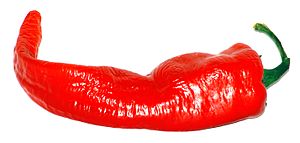Cayenne pepper facts for kids
The cayenne pepper is a type of chili pepper that adds a spicy kick to food! It's also known by other names like red hot chili pepper or bird pepper. Cayenne peppers are part of the Capsicum annuum plant family, which also includes common vegetables like bell peppers, jalapeños, and paprika. All these plants belong to the nightshade family.
This hot pepper is named after the city of Cayenne, which is the capital of French Guiana. People often dry the peppers and grind them into a powder, which is the spice we call "red pepper" or "cayenne pepper."
Cayenne pepper is used in many spicy dishes around the world, especially in Korean and Sichuan food. You can find it as a powder, whole, or in thin, vinegar-based sauces. Its spiciness is measured on the Scoville scale, and cayenne peppers usually rate between 30,000 and 50,000 Scoville units.
Contents
Growing Cayenne Peppers
Most types of cayenne peppers, which are Capsicum annuum, can grow in many different places, from warm tropical areas to cooler temperate zones. They usually take about 100 days to grow fully.
These peppers love warm, moist soil that's full of nutrients. They grow best in a warm climate. Cayenne plants can reach about 0.5 to 1 meter (1.5 to 3 feet) tall. If you're planting them in a garden, it's good to space them about 1 meter (3 feet) apart. However, in smaller gardens or pots, you can plant them closer, around 30 centimeters (1 foot) apart. This might mean each plant produces a bit less, but you'll get more peppers from a smaller area!
In very warm places, chili plants can live for more than one year. But in cooler climates, people usually grow them as new plants each year. If you protect them from frost, they can survive the winter and grow again.
Cayenne Pepper and Your Body
Cayenne pepper is packed with good things for your body, even though you usually eat only a tiny bit! It has a lot of vitamin A, and also contains vitamin B6, vitamin E, vitamin C, riboflavin, potassium, and manganese.
The main reason cayenne pepper feels hot is because of a special compound called capsaicin. When you eat cayenne, capsaicin can make your blood vessels widen and speed up your body's metabolism. This means your body might produce more heat. Some studies suggest that capsaicin can help boost metabolism, which helps with energy balance. It also helps blood flow better to all your important organs, delivering oxygen and nutrients.
Cooking with Cayenne
Cayenne is a very popular spice used in many different types of cooking. You can use it fresh, dried and ground into a powder, or as dried flakes. It's also a key ingredient in many hot sauces, especially those made with vinegar. Some people even sprinkle cayenne pepper on sandwiches to give them a spicy flavor!
Cayenne in Drinks
You might be surprised to find cayenne pepper extract showing up in some new drinks! It's becoming an active ingredient in certain beverages, adding a unique kick.
Images for kids
See also
 In Spanish: Pimiento de Cayena (planta) para niños
In Spanish: Pimiento de Cayena (planta) para niños





